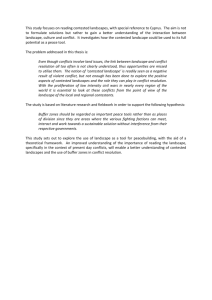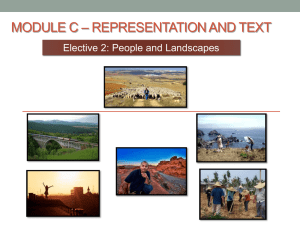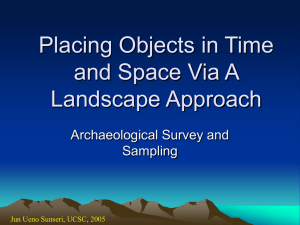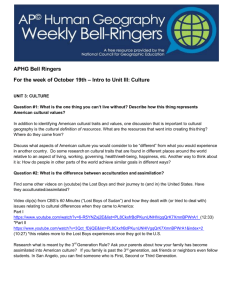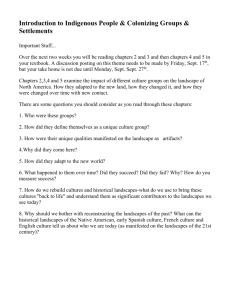History 697U/797U: Landscape and Memory Spring 2014 D
advertisement
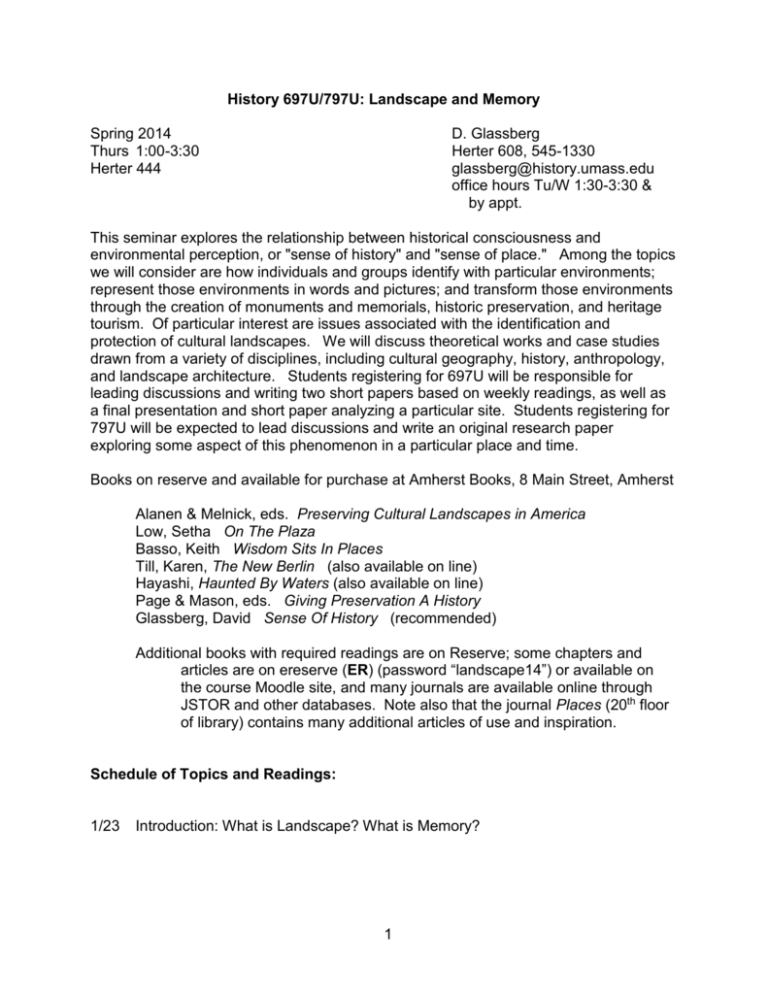
History 697U/797U: Landscape and Memory Spring 2014 Thurs 1:00-3:30 Herter 444 D. Glassberg Herter 608, 545-1330 glassberg@history.umass.edu office hours Tu/W 1:30-3:30 & by appt. This seminar explores the relationship between historical consciousness and environmental perception, or "sense of history" and "sense of place." Among the topics we will consider are how individuals and groups identify with particular environments; represent those environments in words and pictures; and transform those environments through the creation of monuments and memorials, historic preservation, and heritage tourism. Of particular interest are issues associated with the identification and protection of cultural landscapes. We will discuss theoretical works and case studies drawn from a variety of disciplines, including cultural geography, history, anthropology, and landscape architecture. Students registering for 697U will be responsible for leading discussions and writing two short papers based on weekly readings, as well as a final presentation and short paper analyzing a particular site. Students registering for 797U will be expected to lead discussions and write an original research paper exploring some aspect of this phenomenon in a particular place and time. Books on reserve and available for purchase at Amherst Books, 8 Main Street, Amherst Alanen & Melnick, eds. Preserving Cultural Landscapes in America Low, Setha On The Plaza Basso, Keith Wisdom Sits In Places Till, Karen, The New Berlin (also available on line) Hayashi, Haunted By Waters (also available on line) Page & Mason, eds. Giving Preservation A History Glassberg, David Sense Of History (recommended) Additional books with required readings are on Reserve; some chapters and articles are on ereserve (ER) (password “landscape14”) or available on the course Moodle site, and many journals are available online through JSTOR and other databases. Note also that the journal Places (20th floor of library) contains many additional articles of use and inspiration. Schedule of Topics and Readings: 1/23 Introduction: What is Landscape? What is Memory? 1 1/30 Theories and Methods B. Zelizer, “Reading the Past Against the Grain: The Shape of Memory Studies,” Critical Studies in Mass Communication (June 1995): 214-39.ER D. Glassberg, “Public History and the Study of Memory,” Public Historian 18 (Spring 1996); 7-23. Or see Glassberg, “Sense of History,” in Sense of History (2001), pp. 3-22. D. Glassberg, “Interpreting Landscapes,” in Public History and the Environment ed. Melosi and Scarpino (2004), pp. 23-36. P. Groth, “Frameworks for Cultural Landscape Study,” in Understanding Ordinary Landscapes ed. Groth and Bressi (1997), pp. 1-24.ER J.B. Jackson, “The Word Itself,” in Discovering the Vernacular Landscape (1984), pp. 1-8. K. Klein, “On the Emergence of Memory in Historical Discourse,” Representations 69 (2000): 127-50. Yi-Fu Tuan, “Thought and Landscape: The Eye and the Mind’s Eye,” in The Interpretation of Ordinary Landscapes ed. D. Meinig (1978), 89-102.ER Raymond Williams, “Ideas of Nature,” in Problems in Materialism and Culture: Selected Essays (1980), pp. 67-85.ER A. Baker, “Introduction: On Ideology and Landscape,” in Ideology and Landscape in Historical Perspective ed. Baker and Biger (1988), 1-14.ER D. Hayden, “Urban Landscape History: The Sense of Place and the Politics of Space,” in Understanding Ordinary Landscapes ed. Groth and Bressi (1997), pp. 111-33. also in Hayden, The Power of Place, pp. 14-43. A. Spirn, “Landscape Genres,” in The Language of Landscape (1998), pp. 5477.ER D. Lowenthal, “Past Time, Present Place: Landscape and Memory,” Geographical Review (January 1975): 1-36. 2/6 Case Study: History and Public Space in San José Costa Rica S. Low, On the Plaza: The Politics of Public Space and Culture 2/13 Forms of Representation: Words K. Basso, Wisdom Sits in Places J.B. Harley, “Maps, Knowledge, and Power,” in The Iconography of Landscape ed. Cosgrove and Daniels (1988), 277-312.ER E. Casey, “Retangularity & Truth, “in Representing Place: Landscape Painting and Maps (2002) pp. 215-30 ER 2 2/20 Forms of Representation: Pictures M. Sandweiss, “Westward the Course of Empire,” in Print the Legend: Photography and the American West, pp. 156-206. ER J. Sears, “Scenery as Art: Yosemite and the Big Trees,” in Sacred Places: American Tourist Attractions in the 19C, pp. 122-55.ER S. Schama, “The Verdant Cross,” Landscape and Memory, pp. 185-206.ER R. Williams, “Ideas of Nature,” in Problems in Materialism and Culture, pp. 67-85. ER E. Casey, “Pursuing the Natural Sublime: Thomas Cole’s Oxbow, “ in Representing Place: Landscape Painting and Maps (2002) S. Daniels, “The Political Iconography of Woodland in Later Georgian England,” in Iconography of Landscape ed. Cosgrove and Daniels (1988), 43-82.ER Picturing Old New England: Image & Memory ed. W. Truettner & R. Stein (1999) D. Brown, Inventing New England: Regional Tourism in the 19th Century P. Cenkl, This Vast Book Of Nature: Writing The Landscape Of New Hampshire’s White Mountains, 1784-1911 (2006). 2/27 Forms of Intervention: Marking and Obliteration K. Till, The New Berlin: Memory, Politics, Place J. B. Jackson, “The Necessity for Ruins,” in The Necessity for Ruins (1980), pp. 89-102.ER J. O’Brien, “Replacing,” in Firsting and Lasting: Writing Indians Out of Existence in New England (2010), pp. 55-104. K. Foote, Shadowed Ground: America’s Landscapes of Violence and Tragedy L. Lippard, Lure of the Local: Senses of Place in a Multicentered Society (1997) M. Potteiger & J. Purinton, “Openings,” in Landscape Narratives: Design Practices for Telling Stories (1998)ER H. Seine & S. Webster, eds, Critical Issues in Public Art: Content, Context, Controversy (1992) W. Logan, “Hoa Lo: A Vietnamese Approach to Conserving Places of Pain and Injustice,” in Culture, Place, Identity ed. Garnham & Jeffery (2005), pp. 152-60. Asaf's (Blondi) memorial web site: www.Blondi.co.il Israel's Terror victims commemorations: www.ezy.co.il 3 3/6 Landscape and Identity: Migration and Attachment Jane Grenville, “Conservation as Psychology: Ontological Security and the Built Environment,” International Journal of Heritage Studies 13 (November 2007): 447-461. Yi-Fu Tuan, “Rootedness vs Sense of Place,” Landscape 24 (1980):3-8.ER D. Glassberg, “Place and Placelessness in American History,” in Sense of History, pp. 109-27. C. Cooper Marcus, “Environmental Memories,” in Place Attachment ed. I. Altman and S. Low (1992), 87-112.ER L. Chawla, “Childhood Place Attachments,” in Place Attachment ed. I. Altman and S. Low (1992), 63-85.ER B. Allen, “The Genealogical Landscape and the Southern Sense of Place,” in Sense of Place: American Regional Cultures ed. Allen and Schlereth (1990), 152-63.ER Robert B. Riley, “Reflections on the Landscapes of Memory,” Landscape 23 (1979): 11-18.ER M. Fried, “Grief and Adaptation: The Impact of Relocation in Boston’s West End,” and K. Neustadt, “It is Indeed a Strange and Wonderful Emotion You Arouse: Memory, History, and the Old West End,” in The Last Tenement: Confronting Community and Urban Renewal in Boston’s West End ed. Fisher and Hughes (1992), pp. 80-93, 94-105.ER A. Dawson & M. Johnson, “Migration, Exile, and Landscapes of Imagination,” in Contested Landscapes: Movement, Exile, Place, ed. B. Bender & M. Winer, 319-32.ER Leo Spitzer, “Back Through the Future: Nostalgic Memory and Critical Memory in a Refuge from Nazism,” in Acts of Memory: Cultural Recall in the Present ed. Bal, Crewe, Spitzer (1999), pp. 87-104.ER D. Wrobel, “Remembered Journeys,” in Promised Lands: Promotion, Memory, and the Creation of the American West (2002), pp. 95-119. D. Glassberg, “Making Places in California,” in Sense of History, pp. 165-202.. V. Scharff, “Lighting Out for the Territory: Women, Mobility, and Western Place,” in Power and Place in the North American West ed. R. White and J. Findlay (1999), pp. 287-303.ER 3/13 Landscape and Identity: Ethnicity, Gender, Race, Class R. Hayashi, Haunted By Waters: A Journey Through Race & Place in the American West P. Limerick, “Disorientation and Reorientation: The American Landscape Discovered from the West,” Journal of American History (Dec 1992): 1021-49.ER 4 G. Dubrow, “Asian American Imprints on the Western Landscape,” in Preserving Cultural Landscapes in America, ed. Alanen and Melnick, (2000), pp. 14368. G. Hoskins, “Poetic Landscapes of Exclusion: Chinese Immigration at Angel Island, San Francisco,” in R. Schein, ed. Landscape and Race in the U.S. (2006), 95-111. ER Read other chapters in this book as interested H. Jenks, “The Politics of Preservation: Power, Memory, and Identity in Los Angeles’s Little Tokyo,” in R. Longstreth, ed. Cultural Landscapes: Balancing Nature and Heritage in Preservation Practice, pp. 35-54. D. Hayden, “Invisible Angelenos,” and “Workers Landscapes and Livelihoods,” in The Power of Place, pp. 82-137. W. Deverell, Whitewashed Adobe: The Rise of Los Angeles and the Remaking of its Mexican Past P. Kropp, California Vieja (chapters on Rancho Santa Fe and Olvera Street) L. Aponte-Pares, “Appropriating Place in Puerto Rican Barrios,” in Preserving Cultural Landscapes in America, ed. Alanen & Melnick, (2000), pp. 94111. J. Sewell, “Gender, Imagination, and Experience in the Early 20C American Downtown,” in Everyday America: Cultural Landscape Studies After JB Jackson ed. Groth & Wilson (2003), pp. 237-54.ER T. Hareven & R. Langenbach, “Living Places, Work Places, and Historical Identity,” in Our Past Before Us ed. D. Lowenthal (1981),109-123.ER D. Upton, “White and Black Landscapes in 18C Virginia” in Material Life in America ed. R. St. George, 357-69.ER R. St. George, “Placing Race at Jefferson’s Monticello,” in Cultural Memory and the Construction of Identity ed. Ben Amos and Weissberg (1999), 231-63. R. Weyeneth, “The Architecture of Racial Segregation,” The Public Historian 27 (Fall 2005): 11-44. Spring Break 3/27 Landscape and Identity: Locale and Nation B. Anderson, “Census, Map, Museum” Imagined Communities: Reflections on the Origins and Spread of Nationalism (revised ed.1991), 163-85.ER A. Confino, “The Nation in the Mind,” in The Nation as a Local Metaphor: Wurttemberg, Imperial Germany, and National Memory, 1871-1918, pp. 158-209. E. Linenthal, The Unfinished Bombing: Oklahoma City in American Memory (2001) E. Linenthal , Sacred Ground: Americans and Battlefields P. Shackel, ed. Myth, Memory and the Making of the American Landscape D. Walkowitz and L. Knauer, eds. Memory and the Impact of Political Transformation in Public Space (2004), selections as interested. 5 A. Kelman, A Misplaced Massacre: Struggling Over the Memory of Sand Creek T. Selwyn, “Landscapes of Separation: Reflections on the Symbolism of Bypass Roads in Palestine,” in Contested Landscapes: Movement, Exile, Place, ed. B. Bender & M. Winer, 225-40. C. Bardenstein, “Trees, Forests, and the Shaping of Palestinian and Israeli Collective Memory,” in Acts of Memory: Cultural Recall in the Present ed. Bal, Crewe, Spitzer (1999), pp. 148-68.ER N. Stanley, “Chinese Theme Parks and National Identity,” in Theme Park Landscapes: Antecedents and Variations (2002) ed. T. Young & R. Riley, pp. 269-89. 4/3 Forms of Intervention: Historic Preservation and Heritage Tourism M. Page and R. Mason, eds. Giving Preservation a History (2004) N. Kaufman, “Protecting Storyscapes,” in Place, Race, and Story: Essays on the Past and Future of Historic Preservation (2009), 38-56. R. Francaviglia, “Selling Heritage Landscapes,” in Preserving Cultural Landscapes in America, pp. 44-69. “Introduction: Landscape Preservation in Context, 1890-1950” in Design With Culture: Claiming America’s Landscape Heritage ed. Birnbaum & Hughes (2005), pp. 1-18. D. Lowenthal, “The Past as a Theme Park,” in Theme Park Landscapes: Antecedents and Variations (2002) ed. T. Young & R. Riley, pp. 11-23.ER 4/7 or 4/8 (time TBA; DG out of town 4/10) Forms of Intervention: Civic Engagement, Cultural Conservation and Protected Landscapes “The National Park Service and Civic Engagement” (2001) & website N. Mitchell & Susan Buggey, “Protected Landscapes and Cultural Landscapes,” George Wright Forum 17 (2000): 35-46.ER R. Hester, “Subconscious Landscapes of the Heart,” Places 2 (1985): 10-22.ER M. Hufford, “Stalking the Native View: The Protection of Folklife in Natural Habitats” in The Conservation of Culture: Folklorists and the Public Sector ed. Burt Feintuch (1988), pp. 217-29.ER D. Glassberg, “Rethinking New England Town Character” in Sense of History, pp. 129-63. 4/17 Discuss Paper Drafts 4/24 Discuss Paper Drafts 5/1 Presentations to Department (time TBA) 5/8 Hand in final papers 6



